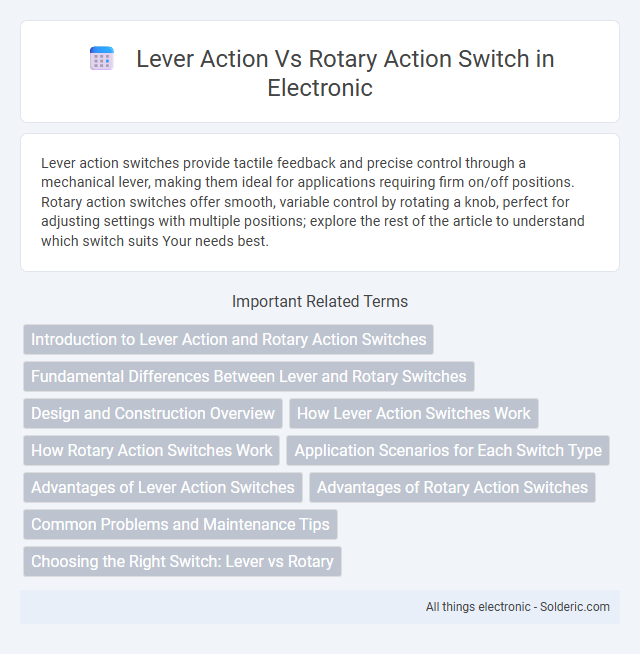Lever action switches provide tactile feedback and precise control through a mechanical lever, making them ideal for applications requiring firm on/off positions. Rotary action switches offer smooth, variable control by rotating a knob, perfect for adjusting settings with multiple positions; explore the rest of the article to understand which switch suits Your needs best.
Comparison Table
| Feature | Lever Action Switch | Rotary Action Switch |
|---|---|---|
| Operation | Manual lever movement | Rotational dial or knob |
| Switch Type | Toggle-style | Rotary-style |
| Use Cases | Simple On/Off control, industrial machinery | Multi-position selection, volume or channel control |
| Positions | Limited (usually two or three) | Multiple distinct positions |
| Feedback | Click or mechanical stop | Detents or smooth rotation |
| Durability | High mechanical strength | Varies; may have wear on rotary parts |
| Installation | Typically panel-mounted lever | Panel or circuit board mounted rotary knob |
| Common Applications | Industrial control panels, toggle switches | Audio devices, instrumentation selectors |
Introduction to Lever Action and Rotary Action Switches
Lever action switches utilize a mechanical lever to open or close electrical circuits, offering precise tactile feedback and simple operation in industrial and consumer applications. Rotary action switches operate by rotating a knob or dial to select different circuit positions, enabling multiple switch states within a compact design. Both switch types are optimized for durability and user control, with lever switches favored in heavy-duty settings and rotary switches common in multi-position applications.
Fundamental Differences Between Lever and Rotary Switches
Lever action switches operate by moving a lever up or down to open or close electrical circuits, providing quick and tactile feedback ideal for on/off control. Rotary action switches function through the rotation of a knob or dial, selectively connecting different circuit paths, making them suitable for multiple position settings in devices like audio equipment. Your choice depends on whether you need simple binary control (lever switch) or multi-position functionality (rotary switch) for your application.
Design and Construction Overview
Lever action switches feature a mechanical arm or lever that moves to open or close an electrical circuit, utilizing a simple pivot mechanism for ease of operation and reliable tactile feedback. Rotary action switches employ a rotating knob or dial, converting rotational movement into electrical contact changes through a cam or detent system, often allowing multiple circuit configurations within a compact form. The construction of lever switches emphasizes robust, straightforward components ideal for quick manual toggling, while rotary switches prioritize precise, incremental control suitable for multi-position settings.
How Lever Action Switches Work
Lever action switches operate by physically moving a lever to open or close an electrical circuit, providing tactile feedback and precise control. The lever pivots on a fulcrum, engaging internal contacts that either complete or interrupt the circuit when moved. This mechanism ensures reliable switching with clear mechanical positioning, making it ideal for applications where you need straightforward, manual control.
How Rotary Action Switches Work
Rotary action switches work by rotating a knob or dial to open or close electrical circuits through multiple contact points arranged in a circular pattern. This design allows for precise control and quick switching between different circuit paths in devices such as audio equipment, appliances, and industrial machinery. Your choice between lever action and rotary action switches depends on the specific application requirements for speed, durability, and ease of use.
Application Scenarios for Each Switch Type
Lever action switches excel in industrial machinery and heavy equipment control panels due to their clear visual feedback and durable mechanical design, supporting high current loads and rugged environments. Rotary action switches are ideal for precision instrumentation, consumer electronics, and audio equipment, offering multiple selectable positions for complex circuit configurations in compact layouts. Each switch type optimizes functionality based on application-specific requirements such as load capacity, user interface complexity, and spatial constraints.
Advantages of Lever Action Switches
Lever action switches offer tactile feedback and precise control, making them ideal for applications requiring quick and accurate switching. Their robust mechanical design enhances durability and reliability in demanding environments. You benefit from easier operation and reduced accidental activation compared to rotary action switches.
Advantages of Rotary Action Switches
Rotary action switches offer precise control and durability, making them ideal for applications requiring reliable and consistent switching. Their compact design allows for efficient use of space in electronic devices, while smooth rotational movement reduces mechanical wear compared to lever action switches. High resistance to dust and moisture enhances their longevity, making rotary switches suitable for industrial and harsh environments.
Common Problems and Maintenance Tips
Lever action switches often experience mechanical wear and misalignment, causing inconsistent triggering or failure to reset, while rotary action switches commonly suffer from contact corrosion and dirt buildup that impede smooth rotation and electrical conductivity. Regular cleaning with contact cleaner and lubrication of moving parts can prolong the lifespan of both switch types, preventing electrical faults and mechanical jams. To maintain optimal functionality, inspect Your switches periodically for signs of wear, ensure tight connections, and avoid exposure to moisture and dust.
Choosing the Right Switch: Lever vs Rotary
Choosing between a lever action and rotary action switch depends on your device's operational needs and user interface preferences. Lever action switches provide clear, tactile feedback with distinct on/off positions, making them ideal for applications requiring quick and precise control. Rotary action switches offer multiple selectable positions and smooth transitions, perfect for devices needing variable settings or power levels.
lever action vs rotary action switch Infographic

 solderic.com
solderic.com